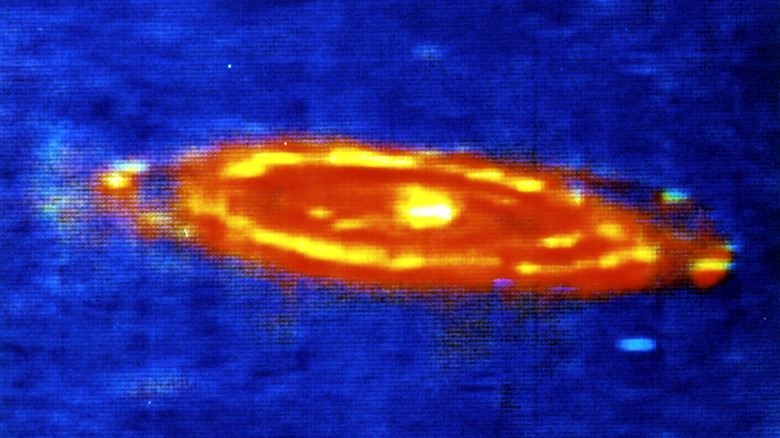The Distant Planet That's Somehow Both Hot As Lava And As Cold As Ice
Our solar system is a place of extremes. Venus, the hottest of the eight planets (apologies to Pluto), has a temperature on the surface of 900 degrees Fahrenheit (475 Celsius). Per NASA, this is because its heavy and oppressive carbon dioxide atmosphere traps heat so very effectively in conjunction with all the sulfuric acid that permeates it. By contrast, World Atlas reports, Uranus is the coldest planet in the solar system, reaching temperatures as low as -371 Fahrenheit (-224 Celsius).
Mind-boggling temperatures such as these make our planet Earth such a wonder. It's able to support a huge array of different species, boasting an atmosphere just perfect to do so. Surrounded by freezing, scalding, gigantic balls of gas as it is, we've got to appreciate Earth's desire to be a little less extreme.
The temperatures on Venus and Uranus are truly astonishing, but out in the unknowable expanse of space, even more shocking things await. A planet that is half fiery and half frozen, for instance.
The dramatic planet of Upsilon Andromeda b
As Space.com reports, the planet Upsilon Andromeda b is a part of the Andromeda constellation, named for Upsilon Andromeda, a star which is 40 light years away from the solar system we call home. Universe Today adds that this constellation is incredibly vast — it stretches for 200,000 light years).
One of the most remarkable features of Andromeda is the aforementioned Upsilon Andromeda b. It is, per Space.com, a gas giant, and it has a fascinating trait: It is the first known planet (beyond the Milky Way) where the temperature at the surface differs. It's wildly different, too.
In October of 2006, per NASA, the Spitzer Space Telescope studied the temperature across this intriguing planet, and reported that there was around an average 2,500 Fahrenheit (1,371 Celsius) difference between its warm and cold side. Per Space.com, it is as cold as -4 Fahrenheit (-20 Celsius) on the side that does not face the planet's star, and up to 3,000 Fahrenheit (1,650 Celsius) on the side that does. The University of California's Brad Hansen stated, per NASA, that passing from one side to another would theoretically be "equivalent to leaping into a volcano."
The mystery of the warm spot
According to NASA, this seems to result from the properties of Upsilon Andromeda b's atmosphere. By absorbing light quickly and essentially dispersing it, a wildly different temperature results.
This planet is a relatively new discovery, having been found in 1996. As is so often the case for astronomers, though, it is one that has caused a new understanding of the nature of space and what awaits us there, as well as evoking more mysteries. Another curious twist to the story occurred in 2009. That year, per Universe Today, the Spitzer Space Telescope engaged in a longer investigation of the planet. "The original report was based on just a few hours of data, taken early in the mission, to see whether such a measurement was even possible," Brad Hansen explained at the time. After a more in-depth investigation, it transpired that the hottest side of the planet was the one that did not "face" its star. While this is not a particular anomaly for such planets ("There are several exoplanets observed with warm spots, including some whose spots are shifted relative to the location facing the star," per Hansen), it's intriguing because science isn't sure what is causing this particular, and seemingly very large, warm spot.
"We have only a very crude measure of this, so we have modeled as basically two hemispheres — one hotter than the other," Hansen ventured, indicating that the planet and this intriguing realm of space have many more secrets to unravel.


